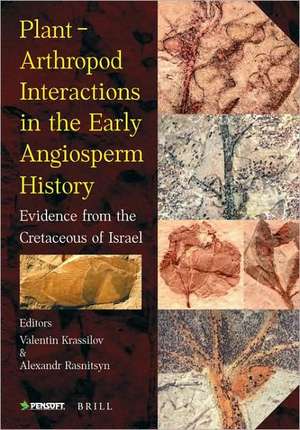Plant-Arthropod Interactions in the Early Angiosperm History: Evidence from the Cretaceous of Israel
Autor Valentin Krassilov, Alexandr Rasnitsynen Limba Engleză Hardback – 26 iun 2008
Co-published by Pensoft Publishers & Brill Academic Publishers
Preț: 792.15 lei
Preț vechi: 966.04 lei
-18% Nou
Puncte Express: 1188
Preț estimativ în valută:
151.60€ • 164.61$ • 127.34£
151.60€ • 164.61$ • 127.34£
Carte indisponibilă temporar
Doresc să fiu notificat când acest titlu va fi disponibil:
Se trimite...
Preluare comenzi: 021 569.72.76
Specificații
ISBN-13: 9789004170711
ISBN-10: 9004170715
Pagini: 229
Dimensiuni: 165 x 236 x 18 mm
Greutate: 0.68 kg
Editura: Brill
Colecția Brill
ISBN-10: 9004170715
Pagini: 229
Dimensiuni: 165 x 236 x 18 mm
Greutate: 0.68 kg
Editura: Brill
Colecția Brill
Cuprins
PART I
Traumas on Fossil Leaves from the Cretaceous of Israel
1. Introduction
2. Acknowledgements
3. Material and methods
4. Stratigraphic overview of Cretaceous fossil plant/insect
localities in Israel and adjacent countries
5. Plant communities
6. Taphonomy of phyllostigmas
7. Functional morphology of phyllostigmas
8. Morphological classification of phyllostigmas
9. Diversity of Cretaceous phyllostigmatic structures
10. Plant – arthropod interactions
11. Environmental variables
12. Systematic descriptions of phyllostigmas
PART II
Fossil Insects in the Cretaceous Mangrove Facies of Southern Negev, Israel
1. Introduction
2. Systematic description
3. Conclusion
4. Acknowledgements
Traumas on Fossil Leaves from the Cretaceous of Israel
1. Introduction
2. Acknowledgements
3. Material and methods
4. Stratigraphic overview of Cretaceous fossil plant/insect
localities in Israel and adjacent countries
5. Plant communities
6. Taphonomy of phyllostigmas
7. Functional morphology of phyllostigmas
8. Morphological classification of phyllostigmas
9. Diversity of Cretaceous phyllostigmatic structures
10. Plant – arthropod interactions
11. Environmental variables
12. Systematic descriptions of phyllostigmas
PART II
Fossil Insects in the Cretaceous Mangrove Facies of Southern Negev, Israel
1. Introduction
2. Systematic description
3. Conclusion
4. Acknowledgements
Recenzii
“This book explores the traces of the Arthropoda on fossil leaves (phyllostigmas) of the Cretacean period in the Negev desert, when the Angiosperms appeared and increased. A very beautiful book with magnificent color plates of insect and plant fossils. Well done by the publishers and a detailed reconstruction of a relatively unknown environment, especially in this part of the world. As they say at the stock market: buy without hestitation.”
Pierre Jolivet.
“A well-designed book with beautiful photos, mostly in color. … a fascinating book, especially also for fans of gills, mines and other tracts on leaves of present-day plant species, who wish to know about such track from the early development of angiosperms.” By Ron Beenen, translated from Entomolgische Berichten 69 (1) 2009.
Pierre Jolivet.
“A well-designed book with beautiful photos, mostly in color. … a fascinating book, especially also for fans of gills, mines and other tracts on leaves of present-day plant species, who wish to know about such track from the early development of angiosperms.” By Ron Beenen, translated from Entomolgische Berichten 69 (1) 2009.
